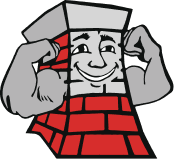Why is My Chimney Rusting?
Unsightly reddish stains on your chimney are often caused by a rusted chimney cap. The moisture that caused your galvanized steel or aluminum chimney cap to rust could also be wreaking havoc in the chimney masonry. It’s important to have annual chimney inspections to keep up with all of the potential problems that can arise due to the vulnerability of masonry to the elements. Read on to learn about the particular issue of rust stains and their removal, the importance of chimney caps, and the various types of materials chimney caps are made with.

How to Remove Rust Stains
Removing stains from a chimney is important because the oxidized material can accelerate deterioration of the masonry. Rust removal is tricky, however. A power washer, for instance, is not recommended because a power spray can easily damage bricks and destroy mortar.
It’s best to call on chimney professionals for rust stain removal if for no other reason than avoiding the danger of climbing onto and working on a roof.
It is important not to use a cleaning material with strong acid on bricks because chemical substances could destroy the brick face. Products made specifically for removal of rust stains from chimney masonry are available and are used by chimney professionals. The trusted products that remove creosote stains, mildew, algae, mortar splatter, and rust stains are an improvement over former options.
In previous times, muriatic acid was a go-to product for removing rust stains, but it has serious drawbacks. First, it is a dangerous substance. Note: Protective gloves and eyewear should be worn when applying any type of masonry cleaner. Secondly, muriatic acid is the type that eats away the bricks.
Replacement of Your Chimney Cap
You may have a chimney cap or a chimney chase cover, and either can rust. Once oxidation, or rusting, begins to occur, it is important to replace the essential appliance. With a new cap or chase top, you can continue to have the benefits the covers provide, including the following:
- Chimney chase tops and chimney caps help to keep rain, snow, and sleet from entering your chimney. Keeping moisture out is important because of the destruction it causes.
- When a flue topper or chase top has mesh, it will keep out debris such as leaves and tree limbs. The mesh also keeps animals out of your chimney. The types of animals known to go into chimneys include raccoons, snakes, birds, bats, and squirrels. If an animal ever gets trapped in your chimney, dead or alive, call a chimney professional immediately. Animals sometimes carry disease, and the process can be dangerous.
- The mesh on a chimney cap also serves as a spark guard that will help to prevent hot embers from escaping the chimney and possibly igniting the roof or other nearby combustible materials.
 Types of Chimney Cap Materials
Types of Chimney Cap Materials
You can avoid having to deal with rust stains in the future by purchasing a chimney cap made of stainless-steel or copper. Both materials are exceptionally durable and will never rust. Galvanized steel and aluminum chimney caps may be far less expensive, but they typically only last a few years before they begin rusting.
Contact the Area’s Certified Chimney Sweeps
Northeastern Chimney is located in West Hartford, Connecticut, and serves the entire surrounding area. All of our chimney sweeps are CSIA-certified and proficient at removing chimney rust stains, installing new chimney caps, performing chimney inspections, and more. We’ve provided reliable chimney services since 1984, and Northeastern Chimney offers a 5-star guarantee. Call us today at 860-233-5770 to schedule an appointment.


